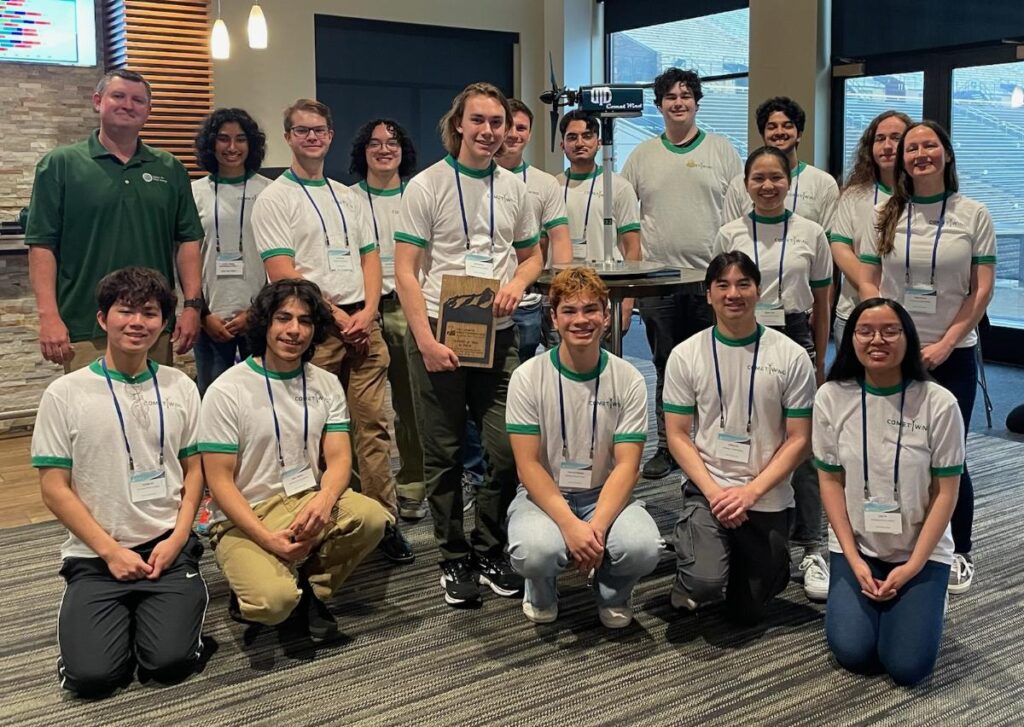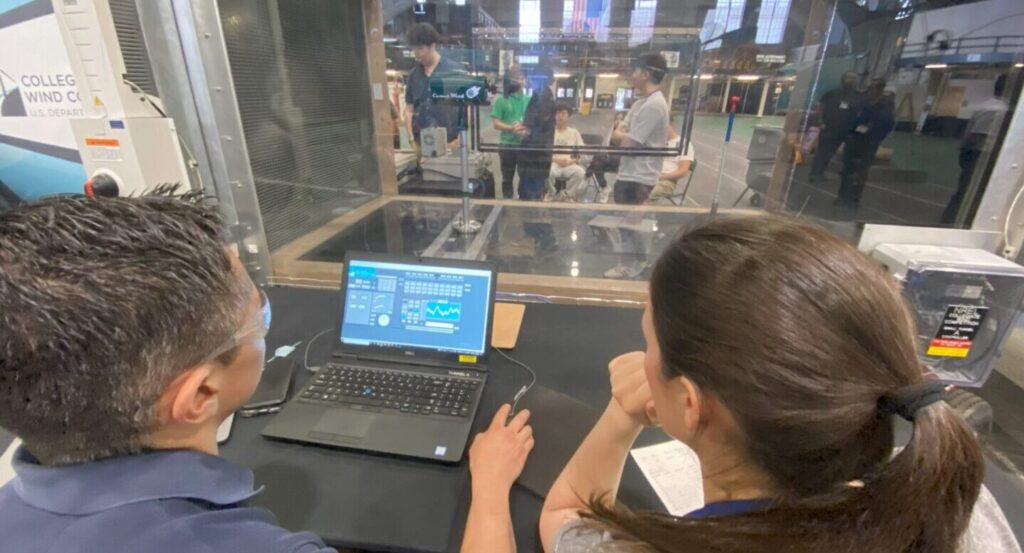10th annual edition of US-national wind energy competition
The U.S. Department of Energy held its 10th annual Collegiate Wind Competition (CWC) in May of this year. 13 out of 30 teams across US colleges had been selected to compete in this final phase of the competition at the University of Colorado Boulder. The competition focuses on preparing college students for jobs in the wind energy workforce through real-world experiences with wind energy technology, project development, finance, communications, and outreach.
Last year, The University of Texas at Dallas (UTD) participated as a non-competing team to learn the ropes of the case studies, challenges and more. However, this year UTD participated with a 40-member team and, according to electrical engineering student Sahithi Chundu, it is only the beginning for the brand-new team.

Pictured here are team members Todd Griffith(advisor), Sahi Chundu, Colin Chaney, Kyle Mizumoto, Kyle Settelmaier, Erick Sandhu, Juan Fernando Harmjanz, Pranav Marthi, Ethan Ferguson (top row), Dan Bouzolin, Alyssa Tran, Robin Reeves (middle row), Kevin Sun, Abner Beltran, Jose Marquez, Vinhson Ho, and Lana Vu (bottom row).
“The wind industry is really taking off in the US, especially in our university’s home state of Texas. Because of the immense motivation and curiosity that our students have towards sustainability and renewable energy, we have a great foundation for our wind energy club. Next competition cycle, we plan to take on even more ambitious projects than we did this year—trying to go above and beyond the rubric and seeing where innovation takes us. This innate curiosity to push the boundary of our work as engineers and individuals is in our team’s DNA. This helps us problem solve and optimize, enabling us not only to succeed at this competition but also in the future wind workforce.”
The UTD team is student-led and includes members across different education majors, such as mechanical engineering electrical engineering, and computer science.
Building a digital twin for case study of bottom-fixed wind turbines with Shoreline simulation software

This year’s CWC called on the teams to develop solutions to challenges regarding siting, project development, and community outreach for fixed-bottom offshore wind farms. The UTD team chose specific lease blocks within their assigned region of the Gulf of Mexico to try and solve the challenge of developing a new hypothetical offshore wind farm and the corresponding site layout and cost-of-energy analysis.
For supporting the justification of their decisions with data-driven arguments, the team utilized Shoreline simulation software for modeling installation and construction scenarios. They used the software for building a digital twin of the wind farm that replicated their installation proposal of 32 9.5 MW Vestas V164 turbines.
“With Shoreline, we were able to simulate how our wind farm would look like. Our main goal was minimizing the levelized cost of electricity (LCOE) as much as possible, and by modelling different scenario campaigns for researching the optimal selection of wind turbines, port infrastructure, and Jones Act-compliant transportation vessels, we were able to generate the desired final data outputs on downtime and average failure rate. Outside the scope of the competition, we learned a great deal about what the wind industry is looking at when it comes to wind farm optimization because of how clear Shoreline made the cost breakdown for aspects such as O&M and LCOE. The nuances of the breakdowns in Shoreline’s software undoubtedly helped us understand the context of some of these numbers and phrases in real-time wind farm operations.”
The UTD team managed to produce an estimated LCOE of $86 per MWh, which comes very close to the industry average of the selected port region and resulted in a 4th place in the overall competition.
Research is key for new wind technology and community outreach
Going forward, there is still plenty of motivation to further engage in wind energy beyond the competition. Most of the team members are keen to join the wind industry and start working with developing and tackle issues and optimization in real-life scenarios.
Therefore, there is also great interest in continuing academic collaboration with Shoreline Wind. It has been highly valuable to the team to gain access to a software used by the industry-leading developers and OEMs. However, it has also been a very steep learning curve for all, as most have no knowledge of data values such as PBA loss. But the ambition is to maximize simulation data outputs even further for next year’s competition.
For Sahithi and her team at UTD, there are still many unique challenges that need to be addressed. With the accelerating pace of new wind turbine technology, and the introduction of floating wind projects, Shoreline is about to open a new chapter of complexity and innovation. A chapter that needs extensive research for reaching its full potential.
“This year’s CWC challenge focused on fixed-bottom turbines, but we believe that the competition may expand to floating wind projects next year. Many new offshore wind areas are dedicated to building floating wind farms, however, the technology still needs a lot of research as floating provides new sets of challenges to infrastructure, port capacity, installation methods, costs and more.”
She further adds how research plays a role into community outreach for the wind industry:
“We think by doing the CWC right and knowing our stuff, we could potentially help reduce the aversion to wind from some NIMBY (not-in-my-backyard) folks. During our project development research for instance, we learned there are many mitigation efforts and development protocols for wind farms which can be implemented in a non-evasive way to benefit both man and the natural environment. It all comes down to proper research that provides the foundation for better outreach with local communities during these development projects. It’s cool how we’re starting to get a taste of that now as college students.”
Academic collaboration and contact information
The collaboration between The University of Texas at Dallas and Shoreline Wind is a part of our academia package. Shoreline simulation software offers access to educational institutes and courses on the development of wind energy.
You can read more about the other academic collaborations in the following articles:
If you have further questions regarding the article, please use the following contact information:
Rolf Winther Christiansen, Head of Marketing & Communication at Shoreline Wind: +45 28 12 53 39
Sahithi(Sahi) Chundu, Finance Lead at The University of Texas at Dallas Wind Energy Club: +1(702) 540 5839
Alyssa Tran, Connection Creation Lead at The University of Texas at Dallas Wind Energy Club: +1(512) 299 4247


